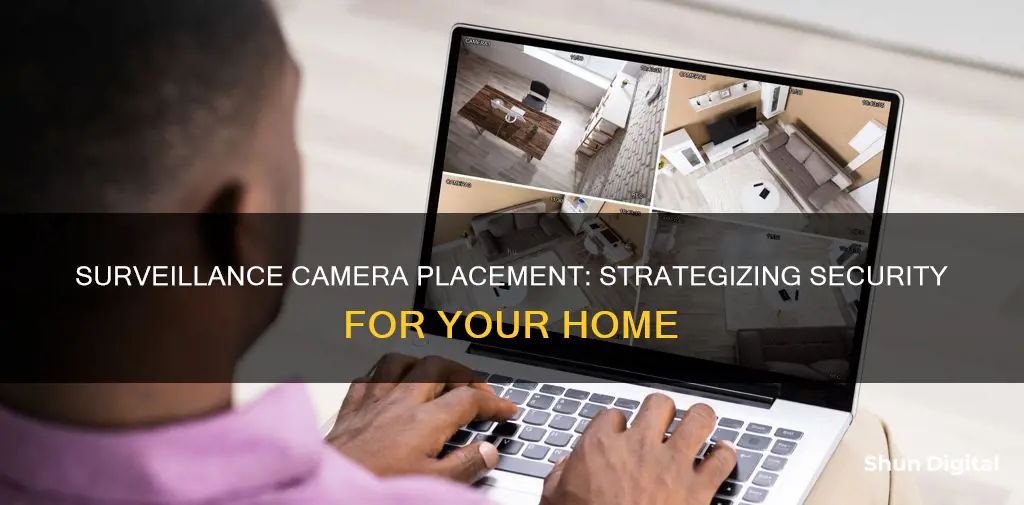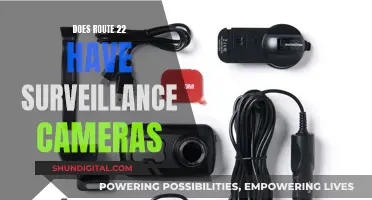
Strategically placing security cameras is a pivotal aspect of creating an effective surveillance system for your home. The effectiveness of your security cameras relies heavily on their positioning, capturing critical footage, and deterring home break-ins. Here are some key considerations for selecting the best locations for your surveillance cameras:
- Entry points and high-traffic areas: Place cameras at main entrances, exits, and high-traffic spots such as hallways, living rooms, and kitchens. This helps deter potential intruders and capture their movements if they enter your home.
- Ground-floor doors and windows: Most burglars enter through ground-floor doors and windows, so ensure you have cameras covering these areas.
- Driveways and garages: Monitoring driveways and garages can help detect suspicious activity and protect valuable items stored in these areas.
- Off-street windows: Windows that don't directly face the street may be more vulnerable to break-ins due to their privacy. Install cameras above these windows or use interior cameras facing them.
- Stairways: Consider placing cameras on stairways, especially if they lead to entry points or connect different levels of your home.
- Height and angle: Mount cameras at a height of 8 to 10 feet to maximize coverage and make them harder to disable. Angle the cameras appropriately to capture the desired field of view and avoid blind spots.
- Lighting and glare: Avoid pointing cameras directly towards the sun or bright lights to minimize glare and ensure clear footage.
- Durability and weather resistance: Choose outdoor cameras with robust designs and weather-resistant features to withstand various weather conditions.
- Visibility: There is a debate about whether to make cameras visible or hidden. Visible cameras may act as a deterrent, while hidden cameras offer a tactical advantage. Consider your security goals and the potential impact on intruders.
- Legal and privacy considerations: Avoid placing cameras in bedrooms, bathrooms, or areas that invade your neighbors' privacy. Check your state's laws regarding surveillance to ensure compliance.
| Characteristics | Values |
|---|---|
| Camera height | 8-10 ft. or higher to cover more area and avoid tampering |
| Camera angle | Angle down towards entrances to avoid only capturing the top of an intruder's head |
| Camera placement | Place cameras at entry points, driveways, porches, garages, yards, high-traffic areas, and stairways |
| Camera durability | Choose cameras with robust designs, weather-resistant features, and suitable temperature ranges |
| Camera visibility | Visible cameras may act as deterrents, while hidden cameras offer a tactical advantage |
| Number of cameras | No set number; depends on the security camera types and locations |
| Camera range | Use a lens with a viewing angle of 90-1100 degrees to avoid distortion |

Front, back, and side doors
The Front Door
The front door is the most common point of entry for burglars, with around 34% of all burglars entering homes through the front of the building. The best way to position a security camera at the front door is to place it around 7 feet up, pointing down at an angle. This is the ideal position to record facial images. Having a camera pointing down at an intruder before they even attempt to enter your home is a great deterrent.
The Back Door
The back door is the second most common point of entry for burglars, with around 22% of burglars entering through the back. Position the camera so that it covers both the door and any adjacent windows. If this is awkward, have one camera covering the door and another at the window. Ensure that the camera systems you choose are fully weatherproof and can resist all kinds of outdoor conditions.
Side Doors
If there is a side door, a burglar will likely try their luck there if they can't get in through the front or back. Therefore, it is important to treat side doors in the same way as the back door when it comes to camera placement.
General Tips
- When selecting a location for your camera, consider any area that has an attic above or an unfinished basement below. Both provide the ability to run wire.
- The height of cameras is often dictated by the architecture of the building. As a general rule, the closer the target location is to a camera, the steeper the field of view will be. To counter this problem, reduce the height of the camera so that the angle of view provides facial ID.
- Standard heights that provide the best field of view are around 8-10 feet.
- Cameras should be placed out of reach of criminals.
The Evolution of Cameras: From First Invention to Now
You may want to see also

Off-street windows
- Height: Place cameras at a height of around 8 to 10 feet. This will make it difficult for potential intruders to access the camera without a ladder and will provide a wider field of view.
- Avoid Blind Spots: Ensure that the camera covers the entire window without any blind spots. Consider using multiple cameras to cover larger windows or placing the camera in a corner to maximize the field of view.
- Lighting: Take into account the lighting conditions, especially if the camera has night vision capabilities. Avoid pointing the camera directly at strong light sources, such as the sun, to prevent glare.
- Field of View: Choose a camera with an appropriate field of view for the size of the window. A 3.6mm lens provides a 90-degree field of view, while a 2.8mm lens offers a wider viewing angle of 110 degrees but may distort the image beyond 40 to 60 feet.
- Motion Detection: Consider using cameras with motion detection features, which can alert you to any activity near the window. Look for cameras that can distinguish between people, pets, and vehicles to reduce false alerts.
- Durability: If the camera is placed outdoors, choose a model that is durable and weather-resistant. Look for cameras with IP ratings that indicate protection against dust and water ingress. Ensure the camera can withstand the temperature range in your area.
- Multiple Cameras: Consider using multiple cameras to cover different angles of the window. This can help eliminate blind spots and provide a more comprehensive view.
- Camera Placement: Place the camera in a discreet location where it is not easily visible from the street. This can help deter potential intruders and reduce the risk of vandalism.
- Test the View: Before installing the camera, test the view from the desired location. Stand at the camera's intended position and observe what you can see. Ensure that there are no obstructions and that the camera will have a clear view of the window.
- Consider Professional Installation: If you are unsure about the best locations for your surveillance cameras, consider consulting a professional. They can provide expert advice and ensure that your cameras are installed correctly and optimally positioned.
Surveillance in Rest Areas: Are You Being Watched?
You may want to see also

Driveways
- Monitor the entire driveway: Place an outdoor camera so that it covers the entire length of your driveway. This will help capture anyone approaching your property, including potential burglars or vandals.
- Consider night vision and lighting: Over 70% of car thefts occur at night, so a camera with night vision capabilities is essential. Consider adding a floodlight or spotlight to illuminate intruders and scare them off.
- Height and placement: Generally, security cameras should be mounted around nine feet high. Installing them too low makes them vulnerable to tampering, while placing them too high may affect video quality and motion detection.
- Field of view: If you want to monitor a large area, such as your entire driveway and yard, choose a camera with a wide field of view. Look for cameras with a field of view of at least 110 degrees.
- Protect your vehicles: Security cameras can help protect your vehicles from theft or vandalism. Place cameras to cover your driveway and garage, and consider adding cameras with license plate identification capabilities.
- Wireless options: Wireless driveway cameras are available and can be a convenient option for monitoring your driveway without the need for complex wiring.
- Avoid blind spots: Ensure your camera placement covers all areas of your driveway and doesn't leave any blind spots that could be exploited by intruders. Consider using multiple cameras or a wider lens to capture a larger area.
- Durability: Driveways are often exposed to the elements, so choose a camera that can withstand weather conditions like rain, snow, and extreme temperatures. Look for cameras with high IP ratings and temperature ranges.
- Multiple cameras: Consider placing multiple cameras along your driveway to capture different angles and ensure complete coverage. This can also help eliminate blind spots and provide a more comprehensive view of the area.
The Evolution of Camera Doorbells: A Comprehensive Guide
You may want to see also

Common areas
When selecting locations for surveillance cameras around your house, it is important to consider common areas such as the living room and kitchen. These are areas that you use on a daily basis and are often the most trafficked parts of the home. Here are some tips for selecting the best locations for surveillance cameras in these common areas:
- Height and placement: It is recommended to place cameras at a height of around 8 to 10 feet to make them harder to disable or steal. Placing cameras in corners of rooms can maximise their field of view, allowing them to capture the entire room.
- Avoid windows: When placing cameras indoors, avoid pointing them directly at windows as this can cause reflection and glare issues, especially at night.
- Consider a wide-angle lens: If you want to capture a large area, such as a living room or kitchen, consider using a wide-angle lens. However, be aware that these lenses can distort the image and reduce clarity beyond a certain distance.
- Think about your lighting: Ensure that your cameras are not pointing directly at light sources, such as lamps or bright windows, as this can wash out the footage. If you are using outdoor cameras, avoid pointing them directly at the sun to prevent glare and high contrast in your footage.
- Test before mounting: Before permanently mounting your camera, test its motion detection by walking in front of it to ensure it reacts as expected.
- Consider a secret service pattern: For maximum coverage, consider using the secret service pattern. This involves installing two cameras on the same wall, separated by 15-20 feet, and aiming them towards each other. This eliminates blind spots and ensures that neither camera can be disabled without the perpetrator being seen.
- Make cameras visible: Visible cameras can act as a deterrent against theft. However, be aware that this may also suggest that you have valuable items worth protecting.
By following these tips, you can effectively select locations for surveillance cameras in common areas around your house, providing both security and peace of mind.
Understanding ZSL Camera Mode: How It Works and Benefits
You may want to see also

Stairways
When placing a camera in a stairway, it is recommended to position it at a height of around 10 feet or higher. This ensures that the camera has a clear view of the stairway and cannot be easily accessed or tampered with. It is also important to consider the angle of the camera. If the stairway has multiple corners, select an angle that minimizes the need for additional cameras while maximizing coverage.
In addition to the stairway itself, you may also want to consider placing a camera in the hallway at the top or bottom of the stairs. This will provide a clear view of anyone coming up or down the stairs and can act as an extra layer of protection.
Another factor to keep in mind is the lighting in the stairway. If the area is dimly lit, consider adding some outdoor lights or using cameras with built-in spotlights to improve visibility. You should also avoid pointing the camera directly at a light source, as this can cause glare and reduce the quality of the footage.
When installing a camera in a stairway, it is important to test the camera's placement before finalizing the installation. This will help ensure that there are no blind spots and that the camera covers the desired area effectively.
Overall, by following these guidelines and considering the specific layout of your home, you can effectively utilize security cameras in stairways to enhance the protection of your property.
Traffic Camera Tickets: How and Why You Get Fined
You may want to see also
Frequently asked questions
The most important areas to cover with your home security cameras are all first-floor doors and windows. Place exterior cameras above or near any doors leading into your home and consider placing cameras inside to include the entryways in their area of coverage. You should also consider placing cameras that cover your front and back yards, driveways, garages, and high-traffic areas inside your home such as hallways, basements, living rooms, and kitchens.
Place cameras eight to 10 feet off the ground. This lets your camera cover the most area in your room and makes them harder to disable or steal.
There is a debate about whether it’s preferable for your cameras to be visible or hidden from potential thieves. Visible cameras may deter thieves by making your home a less attractive target, but they may also suggest that you have a lot to protect. A combination of the two might create a good balance.







